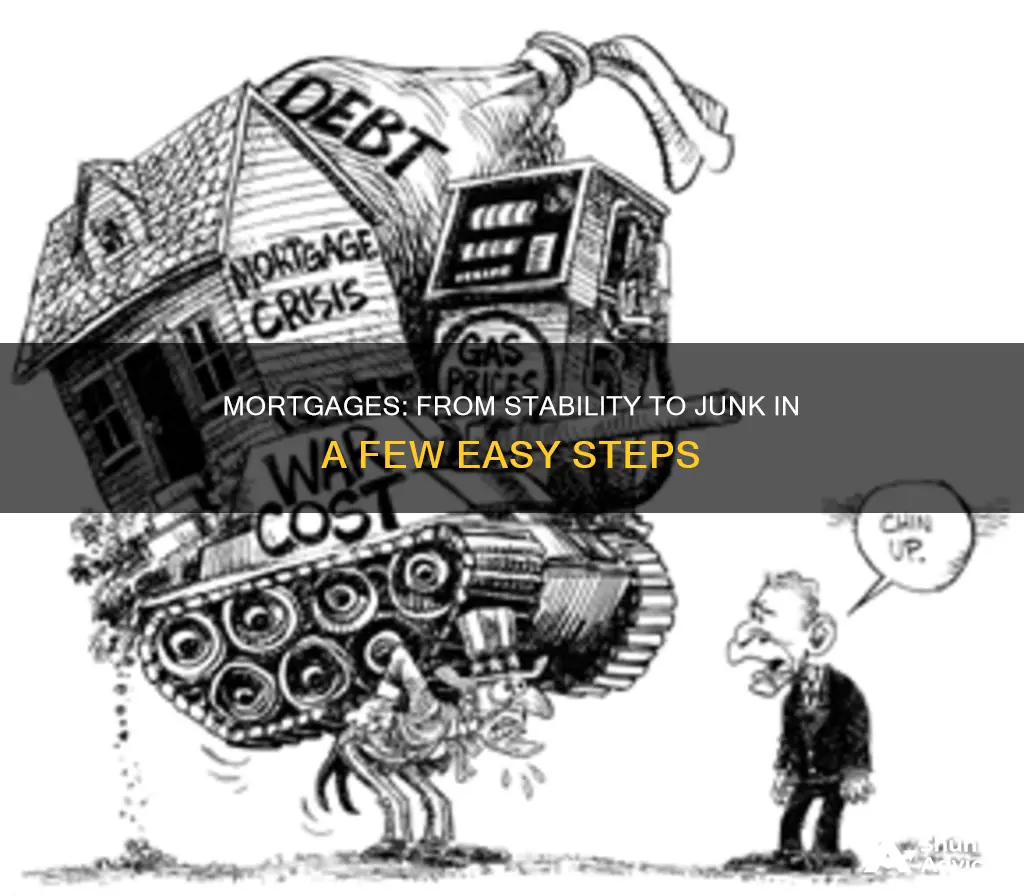
The 2008 Mortgage Crisis was caused by a combination of factors, including risky mortgage products, subprime lending, and housing speculation. In the years leading up to the crisis, banks issued risky loans, such as adjustable-rate mortgages and piggyback loans, which allowed Americans to take out two mortgages simultaneously. These loans were often marketed to unqualified buyers with low credit ratings, who were more vulnerable to unethical banking practices. As a result, when the economy took a turn and interest rates rose, many borrowers struggled to make their mortgage payments, leading to widespread defaults. This, in turn, caused a significant decline in the value of mortgage-backed securities, with nearly $2 trillion in MBS tranches being downgraded to junk status by the end of 2008.
What You'll Learn

Junk fees and excessive closing costs
The Consumer Financial Protection Bureau (CFPB) has been investigating junk fees and excessive closing costs associated with mortgages. Closing costs are the fees paid on the day a borrower finalizes the purchase of a home, and they can include title insurance, credit report and appraisal fees, origination fees, and more. These costs have been rising in recent years, causing concern about overpriced "junk" fees. While these fees are legitimate, they can vary widely between lenders, and not every lender charges every type of fee, giving rise to the "`junk`" label.
Junk fees are unnecessary fees that add costs but provide little to no value. The CFPB has identified several types of junk fees that consumers may unknowingly pay, including excessive late fees, unnecessary inspection fees, fake mortgage insurance premium charges, and fees paid despite financial loss mitigation options. For example, mortgage servicers may charge the highest level of late fees allowed by law, even when the buyer's mortgage caps it at a lower amount. Unnecessary inspections can also result in junk fees, such as when servicers send inspectors to the wrong address and then pass the charge on to the buyer. The CFPB has also found cases where servicers charged private mortgage insurance (PMI) premiums when buyers did not owe them. Additionally, some servicers may fail to waive fees for buyers entering loss mitigation options, such as charging late fees during financial hardship.
Recurring closing costs are expenses paid at closing and each month thereafter, such as real estate taxes. Non-recurring costs are also paid at closing and may include loan origination fees, appraisal fees, and title insurance. From 2021 to 2022, the median total loan costs rose by 21.8%, and the median amount paid by borrowers was nearly $6,000. These costs can strain household budgets and impact the ability to afford a down payment. The CFPB is working to address these issues and has requested input from the public, including borrowers and lenders, to understand how closing costs may be inflated and how costs for borrowers and lenders can be lowered.
Understanding Mortgage Amortization: A Complete Guide to Tables
You may want to see also

Risky mortgage products
The 2008 Mortgage Crisis was caused by a combination of factors, including risky mortgage products. In the years leading up to the crisis, banks issued risky 80/20 loans, also known as "piggyback loans", which allowed Americans to take out two mortgages at once. The primary mortgage covered 80% of the home's price, while a second loan—often used for down payments and closing costs—covered the remaining 20%. These loans were popular among first-time buyers who lacked the savings for a down payment. However, when the recession hit and job losses mounted, millions of homeowners defaulted on their mortgages.
Another factor contributing to the crisis was the rise in subprime lending. This was partly due to Clinton's housing initiative, which aimed to place low-income families into homes. However, these families often had risk factors that resulted in low credit ratings, making them vulnerable to unethical banking practices such as adjustable-rate mortgages. Adjustable-rate mortgages start with a low rate that increases at certain points during the loan term, becoming potentially unaffordable for borrowers over time.
Additionally, there was a broader trend of lowered lending standards and higher-risk mortgage products, which contributed to increased indebtedness among US households. This was further exacerbated by financial products that distributed and potentially concealed the risk of mortgage default.
The crisis was also influenced by the increased power of mortgage originators and the high leverage ratios of major investment banks. These banks had extremely low equity ratios, with a ratio of up to 1:40, making them highly vulnerable to even minor fluctuations in asset values.
In summary, the 2008 Mortgage Crisis was caused by a combination of risky mortgage products, relaxed lending standards, unethical banking practices, and the increased vulnerability of both financial institutions and households.
The Giant Movement Mortgage: How Big Is It?
You may want to see also

High inflation and interest rates
The subprime mortgage crisis was a result of a combination of factors, including high inflation and interest rates. The crisis had severe consequences for the US and European economies, with the US entering a deep recession and losing nearly 9 million jobs during 2008 and 2009.
The crisis was characterised by higher rates of household debt, lower savings rates, and higher housing prices. Between 1997 and 2006, the peak of the housing bubble, the price of the typical American house increased by 124%. This was fuelled by low-interest rates, large inflows of foreign funds, and easy credit conditions. The Fed's interest rate policy during the early 2000s was criticised as being misguided, as it disregarded other factors besides the low rate of inflation.
The rise in subprime lending and the increase in housing speculation were two proximate causes of the crisis. Investors with "prime" or low-risk credit ratings were more likely to default than non-investors when prices fell. This was part of a broader trend of lowered lending standards and higher-risk mortgage products, which contributed to increased household indebtedness.
The vulnerability of the system was further exposed by the precarious financial position of major investment banks. These banks had very low leverage ratios, with a ratio of 1:40 in some cases, meaning they owed $40 for every dollar of equity. This made them highly vulnerable to even minor fluctuations in asset values.
In addition, the inability of homeowners to make their mortgage payments due to adjustable-rate mortgages resetting, borrowers overextending, predatory lending, and speculation also contributed to the crisis. As a result, the market value of mortgages dropped, and nearly $2 trillion in MBS tranches were downgraded to junk between autumn 2007 and mid-2008.
MyFICO Scores: How Close to Mortgage Eligibility?
You may want to see also

Credit rating agencies' mistakes
Credit rating agencies (CRAs) played a significant role in the American subprime mortgage crisis of 2007-2008, which led to the Great Recession of 2008-2009. The "Big Three" CRAs—Moody's Investors Service, Standard & Poor's, and Fitch Ratings—were key players in the process. These agencies gave investment-grade, "money safe" ratings to securitized mortgages, which were based on "non-prime" or subprime mortgages. The high ratings encouraged global investors to fund the housing bubble in the US.
One of the main mistakes made by credit rating agencies was the misjudgment of risk. The agencies underestimated the risk associated with mortgage-backed securities (MBS) and collateralized debt obligations (CDO), which were backed by subprime mortgages. As these mortgages began to default, the agencies were forced to downgrade their ratings. By the end of 2008, 80% of the CDOs by value rated "triple-A" were downgraded to junk, leading to significant losses for investors.
Another mistake made by credit rating agencies was their reliance on flawed computer models and the pressure from financial firms that paid for the ratings. The agencies used faulty financial models that did not accurately assess the risk of default for subprime mortgages. Additionally, there was an absence of meaningful public oversight, which allowed issuers to "shop around" for the best ratings and even threaten to cut off agencies that did not provide the desired ratings.
The structured investment was very profitable for the agencies, accounting for a significant portion of their revenue. This created a conflict of interest, as the agencies were incentivized to provide favourable ratings to secure more business. The dominance of the "Big Three" agencies also limited competition and made it difficult for potential competitors to enter the market.
Overall, the mistakes made by credit rating agencies contributed to the subprime mortgage crisis by providing inflated credit ratings to risky securities, which led to a misallocation of capital and significant losses for investors. The agencies underestimated the risk and did not adequately consider the potential impact of an economic downturn or a decline in the housing market.
Mortgage Deposits: What You Need to Know
You may want to see also

Unqualified buyers
The 2008 Mortgage Crisis was caused by unscrupulous and predatory lending practices of banks, which led to the subprime mortgage crisis. The US and global economies were on the brink of collapse before the bailout. The government promoted loose credit to unqualified or marginal buyers, which caused unintended consequences for the economy.
The Clinton administration advocated for "financing strategies fuelled by creativity to help homebuyers who lacked the cash to buy a home or the income to make the down payments". These efforts provided loans to unqualified buyers, which ultimately had to be fixed by the government.
Blend's Mortgage Revolution: Streamlining the Home Loan Process
You may want to see also
Frequently asked questions
"Junk" fees are the various fees that come with a mortgage, known as closing costs. These charges are in addition to any down payment and interest on the loan. They can include credit report checks, title insurance, and discount points. While these fees are legitimate, they can vary widely from one lender to another, and not every lender charges every type of fee.
The "junk" label is given to these fees because they can come as unexpected charges or seem pricier than they should be. The fees are disclosed to borrowers before a home purchase, but they are not illegal. The term "junk fee" contradicts the White House's definition, which states the lack of disclosure of the fee being charged.
The 2008 mortgage crisis was caused by a combination of factors, including unethical banking practices such as adjustable-rate mortgages, predatory lending, and risky mortgage products. There was also a rise in subprime lending and housing speculation, with investors more likely to default than non-investors when prices fell. The crisis had severe consequences for the US and European economies, with nearly 9 million jobs lost during 2008 and 2009.
"Zombie" mortgages are thought-to-be-dead home loans that resurface when debt collectors start foreclosure proceedings. In the years leading up to the 2008 housing crash, banks issued risky 80/20 loans, which allowed Americans to take out two mortgages at once. When the recession hit, many homeowners defaulted on their mortgages, and banks chose to focus on recovering the bigger main loan. These debts were then sold to debt collectors at a low rate, and as home prices rose again, it became worthwhile for them to go after the money.







